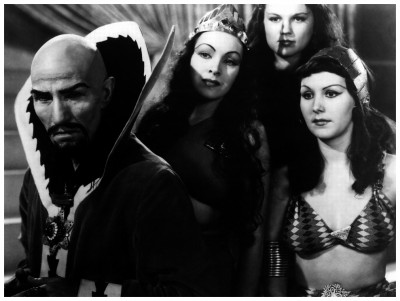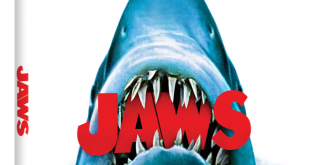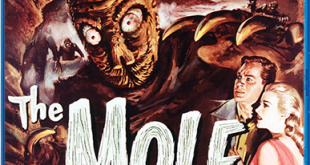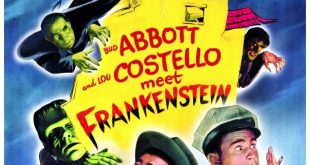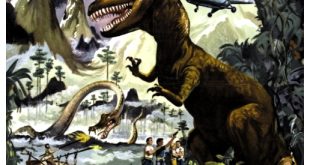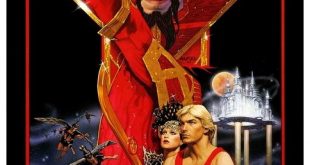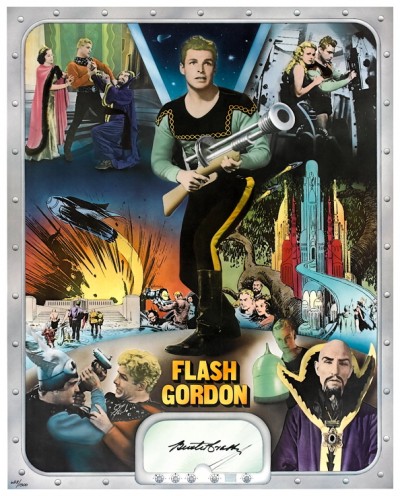 SYNOPSIS:
SYNOPSIS:
“A rogue planet is rushing madly toward the earth. Impending doom creates worldwide pandemonium. But maverick scientist Doctor Zarkov hopes to stay disaster by traveling to the new planet in his experimental rocket. Two chance-met strangers, athletic Flash Gordon and damsel in distress Dale Arden, go with him. Arrived, the trio find Mongo to be a planet of wonders, warring factions, and deadly perils, its orbit controlled by Emperor Ming who has his own sinister plans for earth. Can our heroes, armed only with science and sex appeal, stop him?” (courtesy IMDB)
REVIEW:
Universal Studios had always been a pacesetter as far as the movie serials were concerned, even during the silent days, and produced the first chapterplay with sound, The Indians Are Coming (1930). Its energetic production chief, a Canadian named Henry MacRae who had long been associated with serials, convinced Universal CEO Carl Laemmle to continue making chapterplays well into the thirties. Fast and inventive, the Universal serials of the early thirties might be best represented by The Perils Of Pauline (1933), whose global adventures were mainly drawn from newsreel stock footage (Shanghai street riots, Malay jungle expeditions, etc.) carefully matched with studio backlot close-ups. MacRae was a master at this sort of ‘borrowing’ – in every chapter of the Tarzan-style jungle serial Call Of The Savage (1935), there is at least one long animal fight sequence lifted from forgotten African travelogues. Rather than cheapening the Universal product, however, this grafted footage often lifted settings and storylines out of the routine, making the serials more colourful.
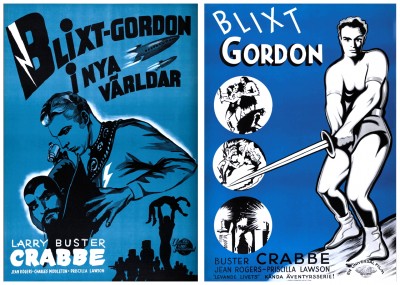 MacRae had long before decided that borrowing good solid stories from other media would be to the serials’ advantage. Whenever possible, Universal serials were taken from established literary properties. Then, in 1934, Universal decided to utilise the plots and heroes of a new art form – the newspaper adventure comic-strip – fast growing in popularity. The first strip chosen for adaptation was Hal Forrest‘s pioneer aviation saga Tailspin Tommy (1934), which chronicled the transformation of a small-town boy into an ace pilot very much in the Lindbergh mold. It proved popular enough to produce a sequel the following year, Tailspin Tommy And The Great Air Mystery (1935), which was also a hit at the box-office. Universal was beginning to enjoy raiding the comics for serial heroes, for not only did the newspaper strips provide ready-made highly visual melodrama in cliffhanger format, they provided a ready-made audience as well.
MacRae had long before decided that borrowing good solid stories from other media would be to the serials’ advantage. Whenever possible, Universal serials were taken from established literary properties. Then, in 1934, Universal decided to utilise the plots and heroes of a new art form – the newspaper adventure comic-strip – fast growing in popularity. The first strip chosen for adaptation was Hal Forrest‘s pioneer aviation saga Tailspin Tommy (1934), which chronicled the transformation of a small-town boy into an ace pilot very much in the Lindbergh mold. It proved popular enough to produce a sequel the following year, Tailspin Tommy And The Great Air Mystery (1935), which was also a hit at the box-office. Universal was beginning to enjoy raiding the comics for serial heroes, for not only did the newspaper strips provide ready-made highly visual melodrama in cliffhanger format, they provided a ready-made audience as well.
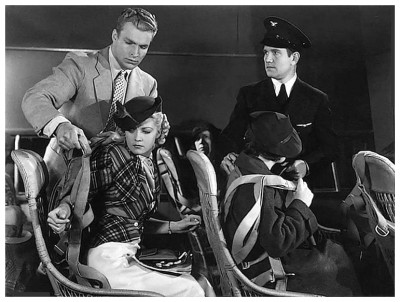 Universal decided its third adaptation would be the new and extremely well-drawn adventure strip set on other planets that in two short years had caused a sensation. Its name was Flash Gordon, and it was created by Alex Raymond. Raymond had started working for King Features after winning a competition to draw the strip for Secret Agent X-9, and soon submitted a sample page of a science fiction adventure comic he had been developing casually. King Features had been looking for a futuristic strip to compete with the fantastically popular Buck Rogers, started in 1929 by a rival syndicate. After a couple of attempts Raymond succeeded with Yale polo champion ‘Flash’ Gordon, who was to be grounded firmly in contemporary times, unlike Buck Rogers, whose adventures were set in the twenty-fifth century. Flash was to stay in the present, finding his excitement on other planets with futuristic cultures.
Universal decided its third adaptation would be the new and extremely well-drawn adventure strip set on other planets that in two short years had caused a sensation. Its name was Flash Gordon, and it was created by Alex Raymond. Raymond had started working for King Features after winning a competition to draw the strip for Secret Agent X-9, and soon submitted a sample page of a science fiction adventure comic he had been developing casually. King Features had been looking for a futuristic strip to compete with the fantastically popular Buck Rogers, started in 1929 by a rival syndicate. After a couple of attempts Raymond succeeded with Yale polo champion ‘Flash’ Gordon, who was to be grounded firmly in contemporary times, unlike Buck Rogers, whose adventures were set in the twenty-fifth century. Flash was to stay in the present, finding his excitement on other planets with futuristic cultures.
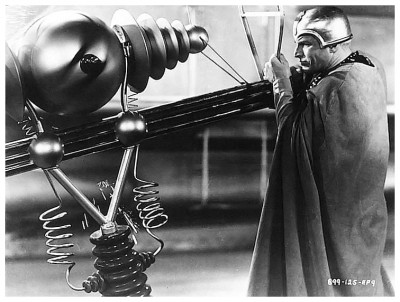 The very first panel was a grabber, with newspaper headlines screaming WORLD COMING TO END! STRANGE NEW PLANET RUSHING TOWARD EARTH! ONLY MIRACLE CAN SAVE US, SAYS SCIENCE! A desperate scientist, the bearded Hans Zarkov, works day and night to avert the end of the world, but his great brain is weakening. In the next panels Flash and pretty Dale Arden, two passengers on a transcontinental plane, find their destinies joined as atmospheric disturbances caused by the onrushing comet force them to bail out of their aircraft in a shared parachute. They land near Zarkov’s observatory and, in turn, somewhat deranged, forces the couple to enter the spacecraft he has constructed nearby. “I intend to shoot this ship at the comet which threatens the Earth! My ship will deflect the comet from its course. We three shall die, martyrs to science!”
The very first panel was a grabber, with newspaper headlines screaming WORLD COMING TO END! STRANGE NEW PLANET RUSHING TOWARD EARTH! ONLY MIRACLE CAN SAVE US, SAYS SCIENCE! A desperate scientist, the bearded Hans Zarkov, works day and night to avert the end of the world, but his great brain is weakening. In the next panels Flash and pretty Dale Arden, two passengers on a transcontinental plane, find their destinies joined as atmospheric disturbances caused by the onrushing comet force them to bail out of their aircraft in a shared parachute. They land near Zarkov’s observatory and, in turn, somewhat deranged, forces the couple to enter the spacecraft he has constructed nearby. “I intend to shoot this ship at the comet which threatens the Earth! My ship will deflect the comet from its course. We three shall die, martyrs to science!”
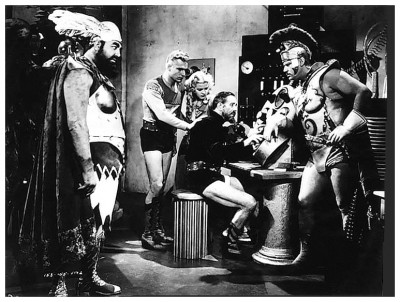 In later segments the missile manages to land on the planet, whose erratic orbit takes it past Earth. The adventurers learn that the world is called Mongo and is inhabited by humanoids ruled by a despicable tyrant of yellowish cast, who looks oddly like a combination of the operatic Mephistopheles and Doctor Fu Manchu, and is named Emperor Ming The Merciless. Almost immediately sides are joined and a titanic struggle has begun. Raymond’s beautiful people – both Flash and Dale were strikingly handsome – conquering fantastic worlds had an instant impact and did much to win new audiences for the adventure strip format. Among his readers were the Universal management and Henry MacRae, hungry for new, different, ready-made heroes.
In later segments the missile manages to land on the planet, whose erratic orbit takes it past Earth. The adventurers learn that the world is called Mongo and is inhabited by humanoids ruled by a despicable tyrant of yellowish cast, who looks oddly like a combination of the operatic Mephistopheles and Doctor Fu Manchu, and is named Emperor Ming The Merciless. Almost immediately sides are joined and a titanic struggle has begun. Raymond’s beautiful people – both Flash and Dale were strikingly handsome – conquering fantastic worlds had an instant impact and did much to win new audiences for the adventure strip format. Among his readers were the Universal management and Henry MacRae, hungry for new, different, ready-made heroes.
 The idea of an interplanetary odyssey, of incredible cities and people, and of a popular property with a pre-sold audience to boot, appealed to Universal, and the studio made a deal for Flash Gordon with King Features, at the same time picking up the film rights to several other King Features characters such as Jungle Jim and Secret Agent X-9. With deliberate care they scripted a faithful translation of the first year of the strip’s continuity. Because of such fanciful alien people as Lion Men and Shark Men had to be brought to the screen, as well as floating cities, underwater cities and monsters of all sizes, the serial was given a total budget that ultimately reached US$350,000, making it the most expensive chapterplay to date and, indeed, in the history of the form.
The idea of an interplanetary odyssey, of incredible cities and people, and of a popular property with a pre-sold audience to boot, appealed to Universal, and the studio made a deal for Flash Gordon with King Features, at the same time picking up the film rights to several other King Features characters such as Jungle Jim and Secret Agent X-9. With deliberate care they scripted a faithful translation of the first year of the strip’s continuity. Because of such fanciful alien people as Lion Men and Shark Men had to be brought to the screen, as well as floating cities, underwater cities and monsters of all sizes, the serial was given a total budget that ultimately reached US$350,000, making it the most expensive chapterplay to date and, indeed, in the history of the form.
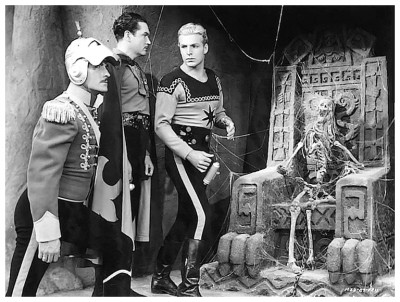 Despite this largesse, Universal indulged in some sharp economics, using bits and corners from whatever sets they felt might do, including massive Egyptian props from The Mummy (1932), and the laboratory and stone steps from The Bride Of Frankenstein (1935). Several scenes, when examined closely, appear to be played quite simply against draperies and props, Vultan’s throne room is a very model of starkness, for example. By spreading its money frugally yet wisely among a large number of settings and miniatures – including fleets of rocketships, barren wastelands, sky cities supported by vast anti-gravity beams – Universal was able to produce from what was actually a fairly modest budget, a creditable epic.
Despite this largesse, Universal indulged in some sharp economics, using bits and corners from whatever sets they felt might do, including massive Egyptian props from The Mummy (1932), and the laboratory and stone steps from The Bride Of Frankenstein (1935). Several scenes, when examined closely, appear to be played quite simply against draperies and props, Vultan’s throne room is a very model of starkness, for example. By spreading its money frugally yet wisely among a large number of settings and miniatures – including fleets of rocketships, barren wastelands, sky cities supported by vast anti-gravity beams – Universal was able to produce from what was actually a fairly modest budget, a creditable epic.
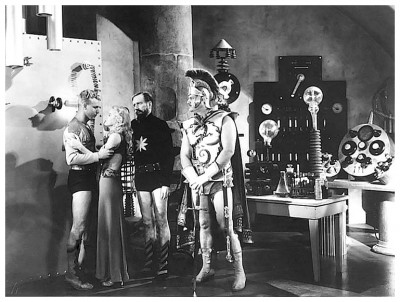 The studio took as much care in choosing its stars. Raymond’s characters were not only handsome and well-drawn, they also had sexual problems novel and daring to the comic strip. While Flash’s affection for Dale Arden was always subdued and nonphysical, there were ceaseless attempts by other women in the strip to separate the lovers and claim Flash for their own. Ming expends considerable energy in the first serial trying mainly to wed and bed Dale Arden – he is completely taken by the Earth girl who, in a departure from the strip, is made blonde as a contrast to Ming’s oriental look and in order that his lust appear more alien.
The studio took as much care in choosing its stars. Raymond’s characters were not only handsome and well-drawn, they also had sexual problems novel and daring to the comic strip. While Flash’s affection for Dale Arden was always subdued and nonphysical, there were ceaseless attempts by other women in the strip to separate the lovers and claim Flash for their own. Ming expends considerable energy in the first serial trying mainly to wed and bed Dale Arden – he is completely taken by the Earth girl who, in a departure from the strip, is made blonde as a contrast to Ming’s oriental look and in order that his lust appear more alien.
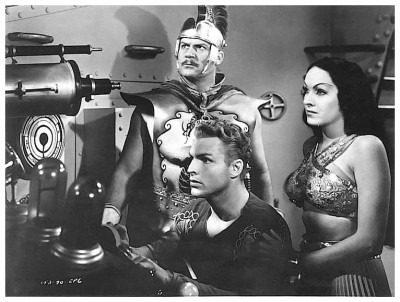 As Dale the studio cast contract player Jean Rogers, who had previously been in their Tailspin Tommy serial and had been a New England beauty-contest winner while still in her teens. She was full of a wholesome youthful sexiness capable of stirring any insane dictator. They gave the role of Emperor Ming to character actor Charles Middleton, who before this had often been typecast as a tight-lipped rural farmer. And yet his performance as the leering, bravura, arm-waving demagogue was unforgettable enough to earn Ming a place in the gallery of great villains.
As Dale the studio cast contract player Jean Rogers, who had previously been in their Tailspin Tommy serial and had been a New England beauty-contest winner while still in her teens. She was full of a wholesome youthful sexiness capable of stirring any insane dictator. They gave the role of Emperor Ming to character actor Charles Middleton, who before this had often been typecast as a tight-lipped rural farmer. And yet his performance as the leering, bravura, arm-waving demagogue was unforgettable enough to earn Ming a place in the gallery of great villains.
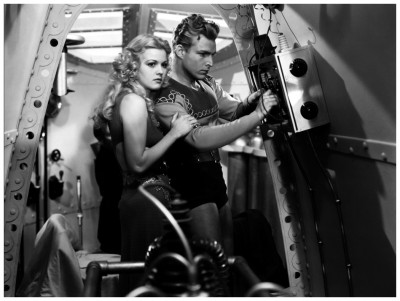 For blonde athletic Flash the studio heads chose especially carefully, since the public already had a detailed image against which to match the selection. After much deliberation they finally decided upon a young Paramount Studios contract player whom they arranged to borrow named Larry ‘Buster’ Crabbe. Not only was Crabbe good-looking and cut to Flash’s heroic mold, he had impeccable physical credentials. He had been a member of the United States Olympic swimming team (1928, 1932), setting many records and winning the gold medal for freestyle swimming. His first film role was as Kaspa The Lion Man in King Of The Jungle (1933) and he had also portrayed the title character in Tarzan The Fearless (1933). Most of his film career until then, however, had consisted of roles in nondescript Westerns and B-grade comedies such as Hold ‘Em Yale (1935). For Buster Crabbe and Flash Gordon it was clearly a case of an actor and a once-in-a-lifetime part waiting to be brought together.
For blonde athletic Flash the studio heads chose especially carefully, since the public already had a detailed image against which to match the selection. After much deliberation they finally decided upon a young Paramount Studios contract player whom they arranged to borrow named Larry ‘Buster’ Crabbe. Not only was Crabbe good-looking and cut to Flash’s heroic mold, he had impeccable physical credentials. He had been a member of the United States Olympic swimming team (1928, 1932), setting many records and winning the gold medal for freestyle swimming. His first film role was as Kaspa The Lion Man in King Of The Jungle (1933) and he had also portrayed the title character in Tarzan The Fearless (1933). Most of his film career until then, however, had consisted of roles in nondescript Westerns and B-grade comedies such as Hold ‘Em Yale (1935). For Buster Crabbe and Flash Gordon it was clearly a case of an actor and a once-in-a-lifetime part waiting to be brought together.
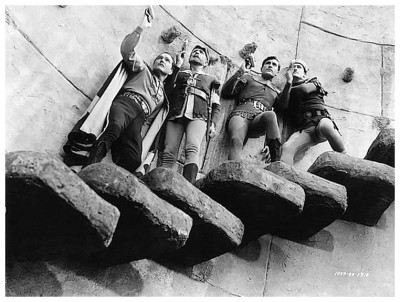 The first chapter of the serial Flash Gordon opens exactly as did the first Sunday page of the strip. The whole world is in a state of frenzy because of the oncoming planet that will soon smash it to atoms. In THE PLANET OF PERIL, the planet of Mongo is on a collision course with Earth. Doctor Alexis Zarkov (Frank Shannon) takes off in a rocket ship to Mongo, with Flash Gordon and Dale Arden as his assistants. They find that the planet is ruled by the cruel Emperor Ming, who lusts after Dale and sends Flash to fight in the arena. Ming’s daughter Princess Aura (Priscilla Lawson) tries to spare Flash’s life. In THE TUNNEL OF TERROR, Aura helps Flash to escape as Zarkov is put to work in Ming’s laboratory and Dale is prepared for her wedding to Ming. Flash meets Prince Thun (James Pierce), leader of the Lion Men, and the pair return to the palace to rescue Dale.
The first chapter of the serial Flash Gordon opens exactly as did the first Sunday page of the strip. The whole world is in a state of frenzy because of the oncoming planet that will soon smash it to atoms. In THE PLANET OF PERIL, the planet of Mongo is on a collision course with Earth. Doctor Alexis Zarkov (Frank Shannon) takes off in a rocket ship to Mongo, with Flash Gordon and Dale Arden as his assistants. They find that the planet is ruled by the cruel Emperor Ming, who lusts after Dale and sends Flash to fight in the arena. Ming’s daughter Princess Aura (Priscilla Lawson) tries to spare Flash’s life. In THE TUNNEL OF TERROR, Aura helps Flash to escape as Zarkov is put to work in Ming’s laboratory and Dale is prepared for her wedding to Ming. Flash meets Prince Thun (James Pierce), leader of the Lion Men, and the pair return to the palace to rescue Dale.
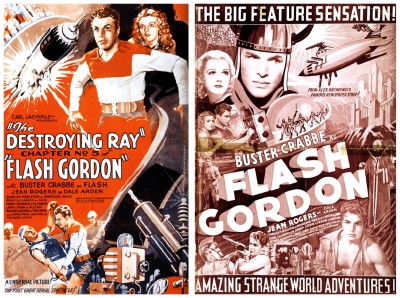 CAPTURED BY SHARK MEN sees Flash stop the wedding ceremony, but he and Dale are captured by King Kala (Duke York), ruler of the Shark Men and a loyal follower of Ming. At Ming’s order, Kala forces Flash to fight with a giant octosak in a chamber filling with water. In BATTLING THE SEA BEAST, Aura and Thun rescue Flash from the octosak. Trying to keep Flash away from Dale, Aura destroys the mechanisms that regulate the underwater city. THE DESTROYING RAY sees Flash, Dale, Aura and Thun escape from the underwater city, but are captured by King Vultan (Jack Lipson) and his flying Hawkmen. Doctor Zarkov befriends Prince Barin (Richard Alexander) and they race to the rescue. In FLAMING TORTURE, Dale pretends to fall in love with King Vultan in order to save Flash, Barin and Thun, who are put to work in the Hawkmen’s atom furnaces.
CAPTURED BY SHARK MEN sees Flash stop the wedding ceremony, but he and Dale are captured by King Kala (Duke York), ruler of the Shark Men and a loyal follower of Ming. At Ming’s order, Kala forces Flash to fight with a giant octosak in a chamber filling with water. In BATTLING THE SEA BEAST, Aura and Thun rescue Flash from the octosak. Trying to keep Flash away from Dale, Aura destroys the mechanisms that regulate the underwater city. THE DESTROYING RAY sees Flash, Dale, Aura and Thun escape from the underwater city, but are captured by King Vultan (Jack Lipson) and his flying Hawkmen. Doctor Zarkov befriends Prince Barin (Richard Alexander) and they race to the rescue. In FLAMING TORTURE, Dale pretends to fall in love with King Vultan in order to save Flash, Barin and Thun, who are put to work in the Hawkmen’s atom furnaces.
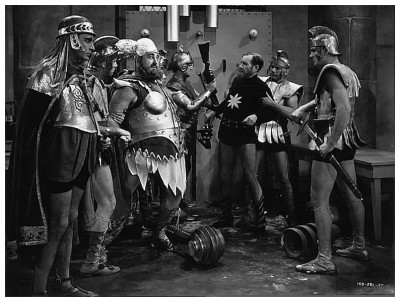 SHATTERING DOOM sees Flash, Barin, Thun and Zarkov create an explosion in the atomic furnaces and, in TOURNAMENT OF DEATH, Doctor Zarkov saves the Hawkmen’s city from falling, earning Flash and his friends King Vultan’s gratitude. Ming insists that Flash fight a tournament to the death against a masked opponent, revealed to be Barin, and then a vicious orangopoid. In FIGHTING THE FIRE DRAGON, Flash survives the tournament with Aura’s help, after she discovers the weak point of the orangopoid. Still determined to win Flash, Aura has him drugged to make him lose his memory. THE UNSEEN PERIL sees Flash recover his memory, but Ming is determined to have Flash executed but, in THE CLAWS OF THE TIGRON, Zarkov invents a machine that makes Flash invisible. Flash torments Ming and his guards. Barin hides Dale in the catacombs, but Aura has her tracked by a tigron. While TRAPPED IN THE TURRET, Aura realises the error of her ways, and quickly falls in love with Barin. She tries to help Flash and his friends to return to Earth, but Ming plots to kill them. In the final episode ROCKETING TO EARTH, Ming orders that the Earth people be caught and killed, but Flash and his friends escape from the Emperor’s clutches, and Ming is apparently killed in a crematorium. Flash, Dale and Zarkov make a triumphant return to Earth.
SHATTERING DOOM sees Flash, Barin, Thun and Zarkov create an explosion in the atomic furnaces and, in TOURNAMENT OF DEATH, Doctor Zarkov saves the Hawkmen’s city from falling, earning Flash and his friends King Vultan’s gratitude. Ming insists that Flash fight a tournament to the death against a masked opponent, revealed to be Barin, and then a vicious orangopoid. In FIGHTING THE FIRE DRAGON, Flash survives the tournament with Aura’s help, after she discovers the weak point of the orangopoid. Still determined to win Flash, Aura has him drugged to make him lose his memory. THE UNSEEN PERIL sees Flash recover his memory, but Ming is determined to have Flash executed but, in THE CLAWS OF THE TIGRON, Zarkov invents a machine that makes Flash invisible. Flash torments Ming and his guards. Barin hides Dale in the catacombs, but Aura has her tracked by a tigron. While TRAPPED IN THE TURRET, Aura realises the error of her ways, and quickly falls in love with Barin. She tries to help Flash and his friends to return to Earth, but Ming plots to kill them. In the final episode ROCKETING TO EARTH, Ming orders that the Earth people be caught and killed, but Flash and his friends escape from the Emperor’s clutches, and Ming is apparently killed in a crematorium. Flash, Dale and Zarkov make a triumphant return to Earth.
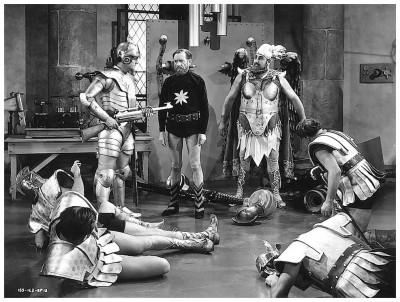 Inspired by Flash Gordon’s success, Universal issued a sequel two years later. Flash Gordon’s Trip To Mars (1938) is a switch in location, but we soon discover that the red planet is a series of kingdoms much like Mongo and that Ming has made himself quite at home there. There is no explanation given of how he escaped death in the previous serial, but in the first chapter of this second effort he is given the opportunity to demonstrate that he can walk through fire. The alert viewer can conclude he is impervious to flame. Ming has convinced Queen Azura of Mars to join him in his favourite occupation, destroying Earth. This time his uses a Nitron Lamp to bombard our planet with Earthquakes and cyclones. Naturally Flash, Dale and Zarkov blast off for Mars to shut off the Nitron Lamp.
Inspired by Flash Gordon’s success, Universal issued a sequel two years later. Flash Gordon’s Trip To Mars (1938) is a switch in location, but we soon discover that the red planet is a series of kingdoms much like Mongo and that Ming has made himself quite at home there. There is no explanation given of how he escaped death in the previous serial, but in the first chapter of this second effort he is given the opportunity to demonstrate that he can walk through fire. The alert viewer can conclude he is impervious to flame. Ming has convinced Queen Azura of Mars to join him in his favourite occupation, destroying Earth. This time his uses a Nitron Lamp to bombard our planet with Earthquakes and cyclones. Naturally Flash, Dale and Zarkov blast off for Mars to shut off the Nitron Lamp.
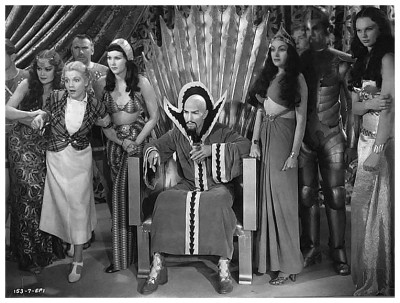 Although its budget was less than its predecessor’s, Flash Gordon’s Trip To Mars offered some of the opulent visuals – the Martian cities are stunning backdrops of domes and light-bridges very much based on Alex Raymond‘s designs – and quite inventive situations. Queen Azura’s political enemies, for instance are transformed by her magical powers into living clay, creatures with clay bodies but lumpy human shapes, forced to remain like some lost race of outcast gnomes in deep grottoes under the surface from which they cannot emerge. Flash eventually liberates the clay people, restoring their humanity, in what many think is the most poetic and best of the three serials. A feature version of this second chapterplay, completed but then shelved, was hastily released under the title Mars Attacks The World one week after Orson Welles‘ infamous radio show of The War Of The Worlds, despite the serials far greater resemblance to a rich and almost medieval fantasy than to H.G. Wells‘ scientific tale of alien invasion.
Although its budget was less than its predecessor’s, Flash Gordon’s Trip To Mars offered some of the opulent visuals – the Martian cities are stunning backdrops of domes and light-bridges very much based on Alex Raymond‘s designs – and quite inventive situations. Queen Azura’s political enemies, for instance are transformed by her magical powers into living clay, creatures with clay bodies but lumpy human shapes, forced to remain like some lost race of outcast gnomes in deep grottoes under the surface from which they cannot emerge. Flash eventually liberates the clay people, restoring their humanity, in what many think is the most poetic and best of the three serials. A feature version of this second chapterplay, completed but then shelved, was hastily released under the title Mars Attacks The World one week after Orson Welles‘ infamous radio show of The War Of The Worlds, despite the serials far greater resemblance to a rich and almost medieval fantasy than to H.G. Wells‘ scientific tale of alien invasion.
 Even though when we last see him on Mars he is about to be disintegrated, two years later, in the third serial to chronicle Flash’s adventures, Ming turns up back on Mongo again, sneering his hatred of Earth and sending a fleet of plague ships to wipe out the human race. Of course, Flash and his friends head for Mongo once more, and this time they have a chance to explore other regions of the planet: the northern wastes of the glacial Frigia, and the lovely forest kingdom of pastoral Arboria. Flash tangles with an army of walking robot bombs called Annihilations, finds and finally frees a degenerate race of Rock Men, related to the Clay People of Mars, living among the craters of the Land Of The Dead, and suffers the treachery of a new ‘Other Woman’ named Sonja (Anne Gwenn).
Even though when we last see him on Mars he is about to be disintegrated, two years later, in the third serial to chronicle Flash’s adventures, Ming turns up back on Mongo again, sneering his hatred of Earth and sending a fleet of plague ships to wipe out the human race. Of course, Flash and his friends head for Mongo once more, and this time they have a chance to explore other regions of the planet: the northern wastes of the glacial Frigia, and the lovely forest kingdom of pastoral Arboria. Flash tangles with an army of walking robot bombs called Annihilations, finds and finally frees a degenerate race of Rock Men, related to the Clay People of Mars, living among the craters of the Land Of The Dead, and suffers the treachery of a new ‘Other Woman’ named Sonja (Anne Gwenn).
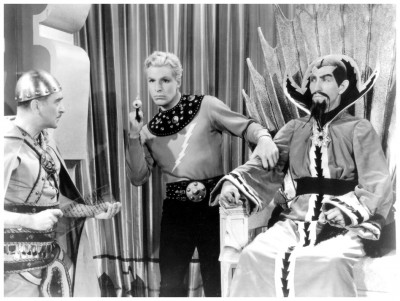 At the end Flash – parachuting out just in time – pilots a rocket into a tower where Ming is about to order the destruction of the Earth. The emperor supposedly perishes in the explosion. A minion chortles: “There is only one way out of the tower, and Ming would probably not have thought of it!” We know, with suspicious lines like that, that we are being set-up for yet another sequel. Zarkov turns to Flash and says with Euclidian logic: “Ming conquered the universe, and you have just conquered Ming. Therefore, Flash Gordon, you have conquered the universe!” The title of this third sequel was indeed Flash Gordon Conquers The Universe (1940) and, really, where can you go from there?
At the end Flash – parachuting out just in time – pilots a rocket into a tower where Ming is about to order the destruction of the Earth. The emperor supposedly perishes in the explosion. A minion chortles: “There is only one way out of the tower, and Ming would probably not have thought of it!” We know, with suspicious lines like that, that we are being set-up for yet another sequel. Zarkov turns to Flash and says with Euclidian logic: “Ming conquered the universe, and you have just conquered Ming. Therefore, Flash Gordon, you have conquered the universe!” The title of this third sequel was indeed Flash Gordon Conquers The Universe (1940) and, really, where can you go from there?
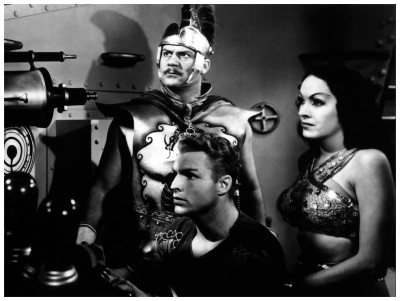 Despite Ming’s secret escape route from his tower, he never turned up again. There was to be no fourth serial. World War Two was beginning and battles here on Earth were taking precedence over tournaments on Mongo. The serials quickly achieved the status of warmly remembered nostalgia and represented the ‘finest moment’ for nearly everyone in them, including Frank Shannon as Zarkov, Priscilla Lawson as sexy Princess Aura, Richard Alexander as a beefy loyal Prince Barin, actors who achieved perfection in their roles yet were hardly ever noticed in anything else again. The serials themselves seemed unduplicatable until filmmakers like George Lucas and Steven Spielberg re-discovered the cliffhanger genre through their productions of Star Wars IV A New Hope (1977) and Raiders Of The Lost Ark (1981).
Despite Ming’s secret escape route from his tower, he never turned up again. There was to be no fourth serial. World War Two was beginning and battles here on Earth were taking precedence over tournaments on Mongo. The serials quickly achieved the status of warmly remembered nostalgia and represented the ‘finest moment’ for nearly everyone in them, including Frank Shannon as Zarkov, Priscilla Lawson as sexy Princess Aura, Richard Alexander as a beefy loyal Prince Barin, actors who achieved perfection in their roles yet were hardly ever noticed in anything else again. The serials themselves seemed unduplicatable until filmmakers like George Lucas and Steven Spielberg re-discovered the cliffhanger genre through their productions of Star Wars IV A New Hope (1977) and Raiders Of The Lost Ark (1981).
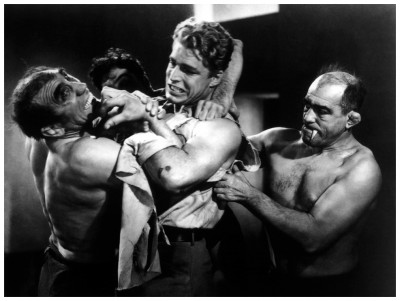 In fact the popularity of the Star Wars films inspired the making of a big-budget version of Flash Gordon (1980) produced by Dino De Laurentiis. It was first slated to be directed by cinematographer Nicolas Roeg, who had a great deal of input as far as design is concerned, but later handed the reigns to director Mike Hodges instead. Starring Sam J. Jones, Melody Anderson, Topol, Max Von Sydow, Timothy Dalton, Brian Blessed, Ornelia Muti, Richard O’Brien and Robbie Coltrane, the screenplay was written by Lorenzo Semple Junior, who intentionally uses his distinctive ‘camp’ style similar to his sixties television series of Batman. Unfortunately, Semple’s tongue-in-cheek humour is not to everyone’s taste, and the film performed rather poorly outside the United Kingdom. Possibly the most notable aspect of the 1980 film is its soundtrack composed and performed by the rock band Queen, which proved such a big seller, Dino De Laurentiis insisted on having a popular rock band associated with his next big production Dune (1984), but that’s another story for another time. I look forward to your company next week when I have the opportunity to freeze the blood in your veins with more sickening horror to make your stomach turn and your flesh crawl in yet another fear-filled fang-fest for…Horror News! Toodles!
In fact the popularity of the Star Wars films inspired the making of a big-budget version of Flash Gordon (1980) produced by Dino De Laurentiis. It was first slated to be directed by cinematographer Nicolas Roeg, who had a great deal of input as far as design is concerned, but later handed the reigns to director Mike Hodges instead. Starring Sam J. Jones, Melody Anderson, Topol, Max Von Sydow, Timothy Dalton, Brian Blessed, Ornelia Muti, Richard O’Brien and Robbie Coltrane, the screenplay was written by Lorenzo Semple Junior, who intentionally uses his distinctive ‘camp’ style similar to his sixties television series of Batman. Unfortunately, Semple’s tongue-in-cheek humour is not to everyone’s taste, and the film performed rather poorly outside the United Kingdom. Possibly the most notable aspect of the 1980 film is its soundtrack composed and performed by the rock band Queen, which proved such a big seller, Dino De Laurentiis insisted on having a popular rock band associated with his next big production Dune (1984), but that’s another story for another time. I look forward to your company next week when I have the opportunity to freeze the blood in your veins with more sickening horror to make your stomach turn and your flesh crawl in yet another fear-filled fang-fest for…Horror News! Toodles!
 Horror News | HNN Official Site | Horror Movies,Trailers, Reviews
Horror News | HNN Official Site | Horror Movies,Trailers, Reviews
